Measures to combat gray mold on tomatoes. Gray rot on tomatoes, signs and methods of control
Harvest from your garden requires a lot of effort and trouble on the part of the owner. This includes constant care and material costs for the purchase of specialized goods, such as fertilizers and pesticides. And in the case of planting plants in a structure called a greenhouse, there are also costs for maintaining the latter in the proper order. A well-maintained greenhouse is shown in the photo.
Tomatoes in a greenhouse
The greenhouse is a good help for the gardener. It can create all the conditions for growing many crops. In general, this is a great way to get a crop even in a not very warm period of time. But if any rules for operating such a device as a greenhouse are not observed, a temperature difference may occur, which will undoubtedly affect the plants located there, and the consequences will be negative.
The time comes when the seedlings are planted, fertilizers are applied for their intended purpose, and only timely weeding and watering remains on the shoulders of the gardener. Harvest time becomes gratitude for the worker, his labors return to the table in the form fresh vegetables and fruits.
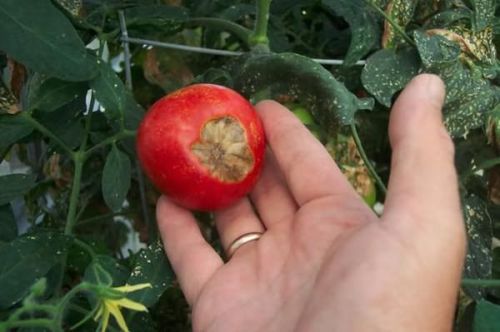
But what to do if waiting for the collection of well-deserved fruits, an unexpected problem of rotting appears? How to correct the situation and get at least some kind of harvest? The answers to these questions can be found in various sources. The measures of influence differ depending on the type of the affected plant and the infection that was picked up by it.
Consider such vegetable crop like a tomato. Probably, not a single housewife can do without it when cooking, so it is present in almost any garden. The greenhouse is also not complete without this culture. There are a great many varieties and varieties of tomato, but, unfortunately, this culture has a lot of diseases. Even rot can be different, as a result of which the methods of dealing with it will also vary.
It all depends on the source of infection. Everything, like other organisms inhabiting the planet. The same bacteria, fungi, viruses and other microorganisms. Infectious and non-infectious causes can also be distinguished. In the first case, the pathogens appear from external environment, penetrate the fetus and begin their unfavorable activity, in the second, violations begin due to genetic causes, improper care or lack thereof, as well as some unintended reasons, for example, unsuitable climate, high or low humidity.
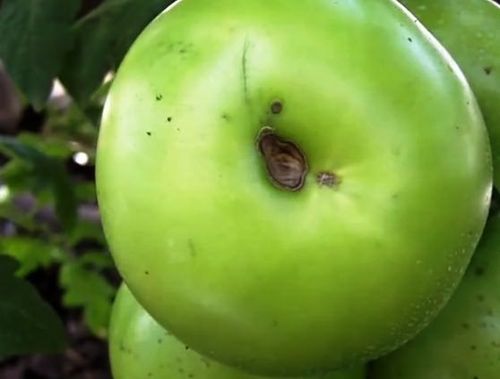
Blossom rot
The most common disease, affecting mainly already ripe fruits. Blossom end rot of tomatoes in the greenhouse reduces the number of harvested fruits. It manifests itself in the form of a dark rotting spot, which slowly grows, gradually capturing the entire surface. It can develop due to bacteria and improper care. The lack of moisture plays a big role in this case. And the lack of loosening leads to a deterioration in breathability. Most often, this disease affects fruits that have an elongated shape. With an infectious method of infection, the fruits deteriorate en masse.
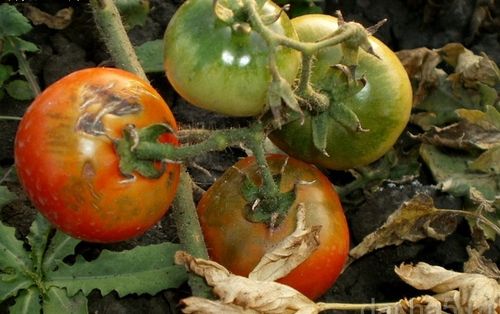
How to deal with the top rot of tomatoes in the greenhouse? When the first signs appear, you need to take immediate action. Treatment is done by improving the care of the crop, for example, cutting by a stepson if this action has not been carried out earlier, tying up bushes, regulating watering, and creating too long intervals between irrigation is detrimental to the crop. The most effective measures include:
- Spraying plants and infusing a solution of calcium nitrate under the root. It is necessary to apply more than once. The operation should be carried out 1-2 times a week. The solution is made at the rate of 10 g of the chemical per bucket of water.
- Irrigation with chalk solution. Folk way. For the effect, a longer period of use is required.
In fact, the fight against top rot of tomatoes in the greenhouse is ongoing. How top rot looks on tomatoes in a greenhouse can be seen in the photo.

Gray rot
The symptoms of this disease are similar to the previous one. Not only fruits become objects of damage, leaves and stems can also suffer. The fighting methods are simple. It is necessary to remove all parts of the plant that have undergone a fungal infection. Brown spots with watery contents appear towards the end of the growing season. Disinfection of the soil on which the tomato beds are located can be of great benefit. Gray rot tomatoes in the greenhouse is very common, as well as white. The photo shows white rot.
root rot
By name it is clear that it is the tomato root that is affected. In this case, unfortunately, only disinfection of the soil can help. With more severe case root rot will need to be replaced upper layer soil. From chemicals a solution of copper sulphate will help. It should be used when pouring under the root of the affected plant. root rot shown in the photo.

internal rot
With this disease, the fetus is no different from the rest. Only when slicing do black blotches become visible in the pulp. In this case, as in all others, infusions for the root system and compliance with all necessary care procedures are necessary.
There are many such diseases. White rot may also occur, it is distinguished by a peculiar fluff and has a fungal appearance, phomosis forms a rotting dark brown spot around the fruit attachment site, and so on. Each has its own symptoms and cures. Most manifestations need to be handled chemicals. Of course, this must be done depending on the disease.
White, gray or brown rot, regardless of the harm from its presence in the garden, is huge. It can deprive the worker of a good part of the harvest. Unfortunately, unique means of protection against any kind of rot have not yet been invented, so you have to get by folk ways or treating plants with chemicals that have some effect on rot. Of course, there is little benefit to a person from a tomato that was fed with chemistry. Therefore, prevention before the appearance of rot, regardless of whether it is white or gray, is mandatory. You just need to ensure full watering, but not from time to time, but regularly. Then you can not neglect the tying up of tomato bushes and circumcision of the so-called "stepsons". After all, they take away moisture from the fruit, thereby stimulating the appearance of signs of disease in tomatoes. The measures taken to prevent rot in tomatoes in the greenhouse will have an effect.
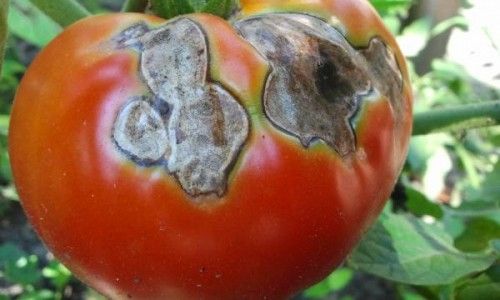
Therefore, when embarking on the cultivation of such a tender crop, you need to fully possess information about the order of care, various subtleties and tricks that help you harvest a more generous harvest. The greenhouse will help in this process with its properties, its use will facilitate your work duties.
Gray rot in some regions causes very serious damage to growing tomatoes. First of all, this disease affects plants whose stems were damaged during their care. The development of gray rot usually occurs at the fruiting stage of tomatoes, and this attack develops best when wet weather sets in. If you do not provide the growing tomatoes with proper care and do not start a timely fight against gray rot, it will spread very actively throughout the greenhouse, affecting the tops of the shoots, as well as inflorescences with ripening fruits.
A few words about the disease
On the tomato nodules affected by destructive gray rot, the formation of grayish-brown spots begins, gradually becoming covered with an unpleasant gray coating. And in the nearest areas near the places where the leaves are detached, the harmful attack manifests itself in the form of brownish elongated spots. In three to five days, all the spots grow along the stems up to four to five centimeters, covering them around the perimeter. A little later, they turn pale in the middle to a pale straw hue, and on close examination you can see ring-shaped blurry stripes on them. By the way, in the first six to eight days after the appearance of such spots, there are no signs of fungal sporulation on them.
Necrosis of the bark and blood vessels often develops inside the tomato stalks, as a result of which, in some areas of the stalks, there is a cessation of water supply, which in turn provokes the rapid wilting of plants. The leaves located just above the necrosis turn yellow, and the formation of an impressive amount of aerial roots begins on the tomato stalks.
When affected by gray rot, the parts of plants located above the spots often wither. And after about a week and a half, an ash-gray plaque forms along the edges of the spots (and sometimes in the center). This is what conidial mushroom sporulation looks like.
In the event of rainy weather, as well as high humidity air, the ill-fated attack can also affect flowers with fruits. By the way, the spots formed on them are characterized by a rounded shape.
How to fight
Despite the fact that protective measures against tomato gray rot have been developed quite well, they are often applied with some delay, and this, in turn, partially reduces the effectiveness of the measures taken.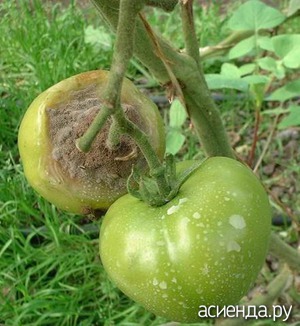
The most important protective measure against the ill-fated disease is considered to be the maintenance of rather low air humidity in greenhouses. In order to reduce the wound surfaces of plants and thereby prevent the successful penetration of infection, it is important to handle tomatoes as carefully as possible, not only when removing leaves and fruits, but also when forming crops. To this end, it is important to cut off the damaged parts of the stems and leaves only in dry weather and with an exceptionally sharp knife.
It is extremely important to remove plant remains from greenhouses, as they contribute to further infection of tomatoes. And the spots on the affected crops are often coated with a special paste with fungicides.
Treatment of growing crops with sodium humate helps to reduce the development and further spread of the stem form of destructive tomato gray rot by one and a half to two times.
For prophylactic purposes, tomato stalks are treated with a Trichodermin suspension. It is especially useful to carry out such treatments after the removal of leaflets (to restrain the development of secondary foci of infection). And among chemicals in the fight against gray rot of tomato, Bayleton and Euparen multi preparations have proven themselves well.
Gray rot is also common in greenhouses, but is especially harmful in film greenhouses. All above-ground organs of plants are affected - leaves, stems, inflorescences, fruits. Brown weeping spots appear on the fabric, which are soon covered with an abundant gray coating. On the stems, mainly in the lower part, elongated spots of gray or Brown color. At first they are dry, then a little slimy. Over time, the stem is ringed. During the growing season, the disease spreads when watering and caring for plants. The disease is more pronounced when plants are damaged (stepping, garter, etc.), but the infection is able to penetrate tissues without damage.
contribute to the development of the disease high humidity(90-95%) and air temperature 17-25°C, poor illumination and dense plantings. The source of infection is the soil and the affected plant residues, on which the spores of the fungus remain.
Relatively resistant to the disease are tomato varieties Otradny and Leningradsky.
Prevention and treatment of tomatoes from gray rot
1. Disinfect the greenhouse by burning sulfur briquettes.
2. Reduce the relative humidity of the air by ventilation.
3. If symptoms of the disease are detected, the affected areas of the stems should be treated with crushed charcoal, chalk, ash, potassium permanganate or blue vitriol(5 g per 1 liter of water).
4. Do not thicken plantings.


